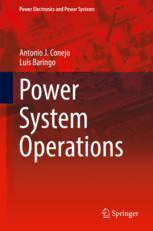Table Of ContentPower Electronics and Power Systems
Antonio J. Conejo
Luis Baringo
Power
System
Operations
Power Electronics and Power Systems
Serieseditors
JoeH.Chow,RensselaerPolytechnicInstitute,Troy,NewYork,USA
AlexM.Stankovic,TuftsUniversity,Medford,Massachusetts,USA
DavidJ.Hill,TheUniversityofHongKong,Pokfulam,HongKong
ThePowerElectronicsandPowerSystemsSeriesencompassespowerelectronics,
electric power restructuring, and holistic coverage of power systems. The Series
comprisesadvancedtextbooks,state-of-the-arttitles,researchmonographs,profes-
sional books, and reference works related to the areas of electric power transmis-
sion and distribution, energy markets and regulation, electronic devices, electric
machines and drives, computational techniques, and power converters and
inverters.TheSeriesfeaturesleadinginternationalscholarsandresearcherswithin
authored books and edited compilations. All titles are peer reviewed prior to
publication to ensure the highest quality content. To inquire about contributing to
the Power Electronics and Power Systems Series, please contact Dr. Joe Chow,
Administrative Dean of the College of Engineering and Professor of Electrical,
Computer and Systems Engineering, Rensselaer Polytechnic Institute, Jonsson
Engineering Center, Office 7012, 110 8th Street, Troy, NY USA, 518-276-6374,
chowj@rpi.edu.
Moreinformationaboutthisseriesathttp://www.springer.com/series/6403
Antonio J. Conejo • Luis Baringo
Power System Operations
123
AntonioJ.Conejo LuisBaringo
IntegratedSystemsEngineering ElectricalEngineering
ElectricalandComputerEngineering UniversityofCastilla-LaMancha
TheOhioStateUniversity CiudadReal,Spain
Columbus,Ohio,USA
ISSN2196-3185 ISSN2196-3193 (electronic)
PowerElectronicsandPowerSystems
ISBN978-3-319-69406-1 ISBN978-3-319-69407-8 (eBook)
https://doi.org/10.1007/978-3-319-69407-8
LibraryofCongressControlNumber:2017958755
©SpringerInternationalPublishingAG2018
Thisworkissubjecttocopyright.AllrightsarereservedbythePublisher,whetherthewholeorpartof
thematerialisconcerned,specificallytherightsoftranslation,reprinting,reuseofillustrations,recitation,
broadcasting,reproductiononmicrofilmsorinanyotherphysicalway,andtransmissionorinformation
storageandretrieval,electronicadaptation,computersoftware,orbysimilarordissimilarmethodology
nowknownorhereafterdeveloped.
Theuseofgeneraldescriptivenames,registerednames,trademarks,servicemarks,etc.inthispublication
doesnotimply,evenintheabsenceofaspecificstatement,thatsuchnamesareexemptfromtherelevant
protectivelawsandregulationsandthereforefreeforgeneraluse.
Thepublisher,theauthorsandtheeditorsaresafetoassumethattheadviceandinformationinthisbook
arebelievedtobetrueandaccurateatthedateofpublication.Neitherthepublishernortheauthorsor
theeditorsgiveawarranty,expressorimplied,withrespecttothematerialcontainedhereinorforany
errorsoromissionsthatmayhavebeenmade.Thepublisherremainsneutralwithregardtojurisdictional
claimsinpublishedmapsandinstitutionalaffiliations.
Printedonacid-freepaper
ThisSpringerimprintispublishedbySpringerNature
TheregisteredcompanyisSpringerInternationalPublishingAG
Theregisteredcompanyaddressis:Gewerbestrasse11,6330Cham,Switzerland
Tothememoryofmyfather,Policarpo
Conejo,whotaughtmewhyinduction motors
rotate.
—AntonioJ.Conejo
Tomyparents,LuisandSacri.
—LuisBaringo
Preface
Power System Operations provides an introduction to power system modeling,
power system steady-state analysis, power system estimation, power system secu-
rity,andelectricitymarkets.
Specifically, this book covers the analysis of three-phase circuits, the modeling
of power system components, the power flow problem, the power system state
estimation problem, and the analysis of power system operation security. It also
provides an overview of electricity markets, including the unit commitment, the
economicdispatch,theself-commitment,andthemarketclearingproblems.
The book embodies a problem-solving approach resulting in an up-to-date
analysisofthemostimportantproblemsinpowersystemoperations,anditincludes
manyillustrativeexamplestoclarifythepowerengineeringconceptscovered.
This textbook is intended for advanced undergraduate and graduate teaching in
power engineering and other engineering disciplines. It is also useful for industry
practitioners since it provides many practical examples developed up to working
algorithms.
Thisbookconsistsofeightchaptersandtwoappendices.
Chapter 1 provides an introduction to power systems, describing its physical,
economic, and regulatory layers, as well as the way in which such systems are
operated. It also describes how power markets work. Finally, it summarizes the
contentsofthebook.
Chapter 2 reviews the analysis of three-phase circuits and defines three-phase
voltages and currents; three-phase active, reactive, and apparent powers; and the
per-unit systems. This chapter provides an appropriate background of three-phase
power for the unfamiliar reader, establishing the link between the physical reality
and analytical techniques. It can be skipped by readers with knowledge of three-
phasecircuitanalysis.
Chapter 3 provides steady-state models for the most common components of a
powersystem,namely,generators,motors,transformers,lines,andloads.
Chapter4addressesthepowerflowproblem,includingnodalequations,admit-
tancematrix,powerflowequations,solutiontechniques,andresultanalysis.
vii
viii Preface
Chapter 5 considers the state estimation problem and includes its formulation,
solution techniques, observability analysis, and bad measurement detection and
identification.
Chapter6addressestheformulationandsolutionofoperationsecurityproblems,
includingtheoptimalpowerflowandthesecurity-constrainedoptimalpowerflow.
Chapter 7 considers a centralized market operation and provides formulation
and solution techniques for the unit commitment, the economic dispatch, and the
network-constrainedunitcommitmentproblems.
Chapter 8 considers a non-centralized market operation and addresses the self-
schedulingproblemandtheformulationofmarketclearingalgorithms.
Finally, Appendix A reviews the solution to nonlinear systems of equations,
whileAppendixBprovidesanintroductiontooptimizationtechniques.
Thematerialinthisbookfitstheneedsofanadvancedundergraduateorgraduate
courseonpowersystemoperations.Chapters1and2maybeskippedifthestudents
arefamiliarwiththeanalysisofpowercircuits.Chapters7and8maybeskippedif
theeconomicoperationsofpowersystemsdonotneedtobecovered.
Thebookprovidesanadequateblendofengineeringbackgroundandanalytical
methods. This feature makes the book of interest to practitioners as well as to
students in power engineering and other engineering fields. Practical applications
are developed up to working algorithms (coded in GNU Octave and GAMS) that
canbereadilyused.
The benefits of reading this book include comprehension of power system
operationproblems,andlearninghowtoformulatesuchproblems,solvethem,and
interpret their solution outputs. This is done using a problem-solving engineering
approach.
To conclude, we would like to thank our colleagues and students at The
Ohio State University and Universidad de Castilla–La Mancha for their insightful
observations,pertinentcorrections,andhelpfulcomments.
Columbus,Ohio,USA AntonioJ.Conejo
CiudadReal,Spain LuisBaringo
June2017
Contents
1 PowerSystems................................................................ 1
1.1 Introduction............................................................ 1
1.2 PowerSystemStructure............................................... 1
1.2.1 PhysicalLayer................................................ 1
1.2.2 EconomicLayer.............................................. 5
1.2.3 RegulatoryLayer............................................. 7
1.3 PowerSystemOperations............................................. 9
1.3.1 Day-AheadOperation........................................ 9
1.3.2 HoursBeforePowerDelivery............................... 10
1.3.3 MinutesBeforePowerDelivery............................. 10
1.4 PowerMarkets......................................................... 10
1.4.1 FuturesMarket............................................... 11
1.4.2 Pool........................................................... 11
1.5 ScopeoftheBook ..................................................... 12
1.5.1 WhatWeDo.................................................. 13
1.5.2 WhatWeDoNotDo......................................... 13
1.6 End-of-ChapterExercises............................................. 14
References..................................................................... 14
2 PowerSystemFundamentals:BalancedThree-PhaseCircuits......... 17
2.1 Introduction............................................................ 17
2.2 BalancedThree-PhaseSequences..................................... 18
2.3 BalancedThree-PhaseVoltagesandCurrents........................ 21
2.3.1 BalancedThree-PhaseVoltages............................. 21
2.3.2 BalancedThree-PhaseCurrents............................. 23
2.3.3 EquivalenceWye-Delta...................................... 28
2.3.4 CommonStarConnection................................... 38
2.4 Instantaneous,Active,Reactive,andApparentPower............... 42
2.4.1 Definitions.................................................... 42
2.4.2 HowtoMeasurePower?..................................... 44
2.5 WhyThree-PhasePower?............................................. 44
ix
x Contents
2.6 Per-UnitSystem ....................................................... 46
2.6.1 Motivation.................................................... 46
2.6.2 Per-UnitSystemDefinition.................................. 46
2.6.3 DefinitionofBaseValues.................................... 48
2.6.4 Per-UnitAnalysisProcedure ................................ 51
2.7 SummaryandFurtherReading........................................ 52
2.8 End-of-ChapterExercises............................................. 52
References..................................................................... 54
3 PowerSystemComponents:Models....................................... 55
3.1 Introduction............................................................ 55
3.2 GeneratorandMotor .................................................. 56
3.2.1 Three-PhaseGenerator ...................................... 56
3.2.2 Three-PhaseMotor........................................... 57
3.3 PowerTransformer .................................................... 58
3.3.1 Definitions.................................................... 59
3.3.2 ConnectionsofaThree-PhasePowerTransformer......... 61
3.3.3 Per-UnitAnalysis............................................ 66
3.3.4 ModelofaThree-PhasePowerTransformer ............... 67
3.4 Load.................................................................... 68
3.4.1 Constant-ImpedanceLoad................................... 69
3.4.2 InductionMotor.............................................. 69
3.4.3 LoadwithConstantPower .................................. 71
3.4.4 LoadwithConstantVoltage................................. 71
3.5 ElectricalLine ......................................................... 71
3.5.1 EquivalentCircuit............................................ 71
3.5.2 ParametersofElectricalLines............................... 75
3.5.3 EfficiencyandRegulation ................................... 80
3.5.4 ActiveandReactivePowerDecoupling .................... 81
3.6 PowerSystemExamples .............................................. 83
3.7 SummaryandFurtherReading........................................ 94
3.8 End-of-ChapterExercises............................................. 94
References..................................................................... 96
4 PowerFlow ................................................................... 97
4.1 Introduction............................................................ 97
4.2 NodalEquations ....................................................... 98
4.2.1 Two-NodePowerSystem.................................... 98
4.2.2 n-NodePowerSystem ....................................... 100
4.3 AdmittanceMatrix..................................................... 101
4.3.1 Two-NodePowerSystem.................................... 102
4.3.2 n-NodePowerSystem ....................................... 102
4.4 PowerFlowEquations................................................. 104
4.4.1 Two-NodePowerSystem.................................... 104
4.4.2 n-NodePowerSystem ....................................... 107

